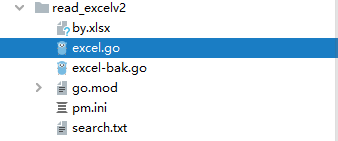一、版本说明
本版本在整合上两次的功能基础上,引进ini配置文件的读取事项,快速读取本地配置文件,完成读取设置
第一版:实现了严格匹配模式的查找
https://blog.csdn.net/wtt234/article/details/131979385第二版:实现了严格匹配模式的查找,以及宽松(关键字的查找)
https://blog.csdn.net/wtt234/article/details/131981275本版本在整合上两次的功能基础上,引进ini配置文件的读取事项,快速读取本地配置文件,完成读取设置
二、前置知识ini文件读取
ini配置文件:
#配置文件的配置地方
#全局配置
static_foldel="./tools"
#mysql局部配置
[mysql]
host = localhost:3306
user = root
password = root
dbname = test[pm]
keydevicelists=语音配线架, 网络配线架, 网络理线架, 终端盒, 光纤收发器, 光纤配线架
devicelists=50对语音配线架, 24口网络配线架, 24口网络理线架, 4口终端盒, 光纤收发器, 96芯光纤配线架 ini文件读取代码
ini文件读取代码
package mainimport ("fmt""github.com/go-ini/ini"
)//中文网站 https://ini.unknwon.cn
//如果您不需要任何对值的自动转变功能(例如递归读取),可以直接获取原值(这种方式性能最佳):
//
//val := cfg.Section("").Key("key name").Value()
//
//判断某个原值是否存在:
//
//yes := cfg.Section("").HasValue("test value")func main() {// 读取INI文件cfg, err := ini.Load("pm.ini")//cfg, err := ini.Load("pm.ini")if err != nil {fmt.Printf("Failed to read file: %v", err)return}//全局配置的获取,//分区读取,默认分区用空字符串表示quanjupm := cfg.Section("").Key("static_foldel").String()fmt.Println(quanjupm)//============================//获取mysql配置段,//读取指定分区mysql := cfg.Section("mysql")fmt.Println(mysql.Key("host").String())fmt.Println(mysql.Key("user").String())//读取一个长字符串格式进行处理keydevicelists := cfg.Section("pm")keySlice := keydevicelists.Key("keydevicelists").Strings(",")fmt.Printf("%v,===>%T", keySlice, keySlice)fmt.Println("===================")//修改文件// 更新INI文件--修改文件//mysql.Key("host").SetValue("newhost")//mysql.Key("user").SetValue("newuser")//mysql.Key("password").SetValue("newpassword")//mysql.Key("dbname").SetValue("newdb")//cfg.SaveTo("conf.ini")
}//vals = cfg.Section("").Key("STRINGS").Strings(",")
三、全部实现代码
项目组织图:

配置文件
pm.ini
#检索关键字的说明信息,keydevicelists,关键字检索
#devicelists,完全内容匹配检索[pm]
keydevicelists=语音配线架, 网络配线架, 网络理线架, 终端盒, 光纤收发器, 光纤配线架
devicelists=50对语音配线架, 24口网络配线架, 24口网络理线架, 4口终端盒, 光纤收发器, 96芯光纤配线架全部代码核心;
package mainimport ("fmt""github.com/go-ini/ini""github.com/xuri/excelize/v2""strings"
)// 我需要检索的信息
// var devicelists []string = []string{"50对语音配线架", "24口网络配线架", "24口网络理线架", "4口终端盒", "光纤收发器", "96芯光纤配线架"}
// var devicelists = []string{"50对语音配线架", "24口网络配线架", "24口网络理线架", "4口终端盒", "光纤收发器", "96芯光纤配线架"}
//
// var keydevicelists = []string{"语音配线架", "网络配线架", "网络理线架", "终端盒", "光纤收发器", "光纤配线架"}
var devicelists []stringvar keydevicelists []stringfunc init() {// 读取INI文件cfg, err := ini.Load("pm.ini")if err != nil {fmt.Printf("Failed to read file: %v", err)return}//读取一个长字符串格式进行处理pmget := cfg.Section("pm")keydevicelists = pmget.Key("keydevicelists").Strings(",")devicelists = pmget.Key("devicelists").Strings(",")}// InSlice 判断字符串是否在 slice 中。
func InSlice(items []string, item string) bool {for _, eachItem := range items {if eachItem == item {return true}}return false
}// InSlice 判断字符串是否在 slice 中。
func includeSlice(items []string, item string) bool {for _, eachItem := range items {//字符串包含函数,判断表格中名字是否包含我的列表中的内容//这样我的找寻字符串中写入关键字就可以了if strings.Contains(item, eachItem) {return true}}return false
}func sheet(sheetname string, f *excelize.File, format int) {//fmt.Println("+++++++++++++++++++++++++")// 获取 Sheet1 上所有单元格rows, err := f.GetRows(sheetname)if err != nil {fmt.Println(err)return}//fmt.Println(rows)for _, row := range rows {//fmt.Println(row, "========", index)//判断每行的里的字段长度,如果是小于6 那就是不获取设备名字和设备价格if len(row) < 6 {continue}//获取excel中,设备的名称kindname := row[1]//获取excel中,设备的数量kcount := row[4]//如果表格中 kcount没有内容,那就是给复制一个“0”字符串if kcount == "" {kcount = "0"}//判断模式,可以进行采用 不同的检索方式//1.包含模式,我检索的都是“关键字” 2.严格模式 ,内容必须得一模一样的查找if format == 1 {//fmt.Println("你匹配的模式为包含模式")//包含的调用if includeSlice(keydevicelists, kindname) {//fmt.Println(sheetname, kindname, "=====++++++=======》", kcount)fmt.Printf("获取信息:sheet表:%s;设备名称:%s;设备数量:%s\n;", sheetname, kindname, kcount)//fmt.Println()}} else {//fmt.Println("你匹配的模式为严格模式")if InSlice(devicelists, kindname) {//fmt.Println(sheetname, kindname, "=====++++++=======》", kcount)fmt.Printf("获取信息:sheet表:%s;设备名称:%s;设备数量:%s\n;", sheetname, kindname, kcount)//fmt.Println()}}}}// 读取Excel表格
func main() {//fmt.Println("====================")//选择的匹配模式:1-包含模式,2-严格模式var mode intf, err := excelize.OpenFile("by.xlsx")if err != nil {fmt.Println(err)return}defer func() {if err := f.Close(); err != nil {fmt.Println(err)}}()sheetnames := f.GetSheetList()//fmt.Printf("本excel表格的sheetnames:%s", sheetnames)//fmt.Println("===============")for {fmt.Println("请输入你需要的匹配模式:1-包含模式,2-严格模式,输入 1 或者 2 :")fmt.Scan(&mode)//fmt.Printf("%T模式为:", mode)//退出内容if mode == 88 {fmt.Println("88..88..")break}//遍历所有的表格sheet,调用处理函数for _, sheetname := range sheetnames {//fmt.Println(sheetname)//fmt.Println("===>", sheetname)sheet(sheetname, f, mode)}}}

)








)






)

